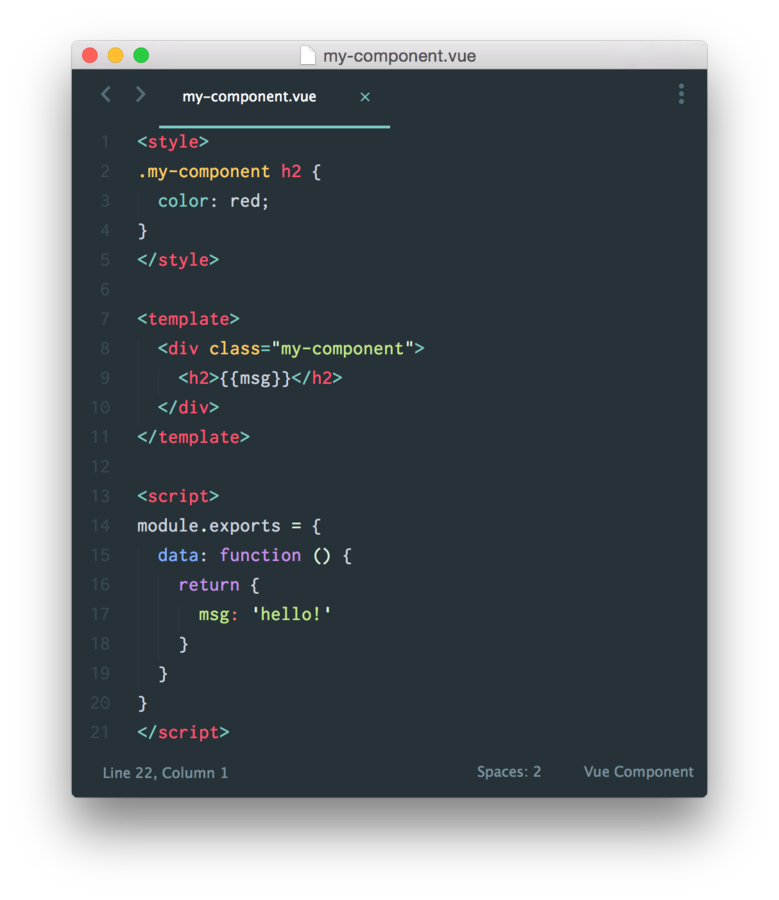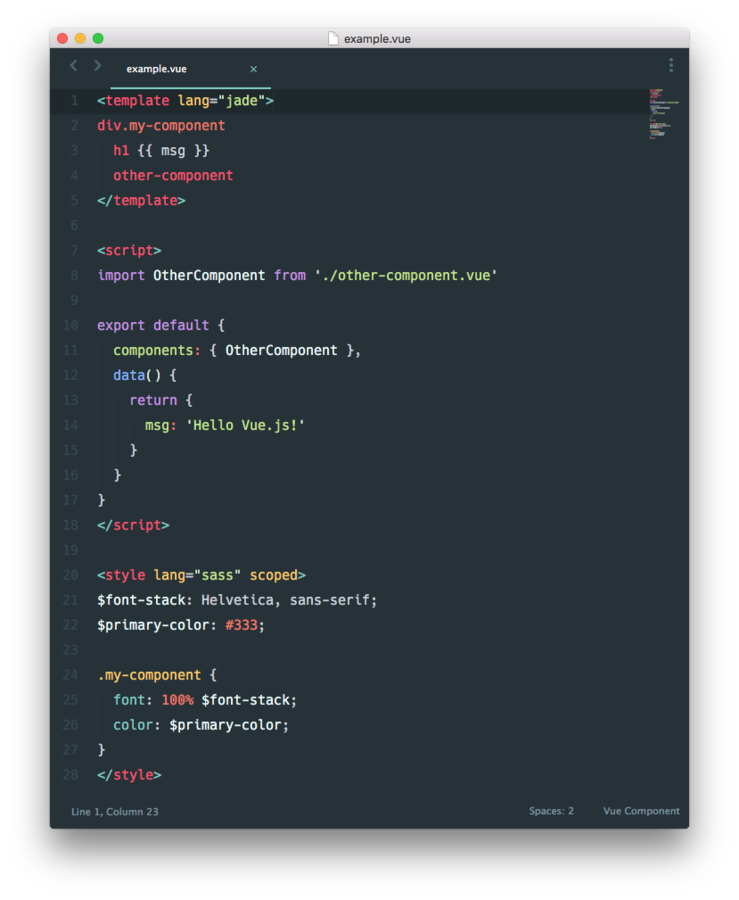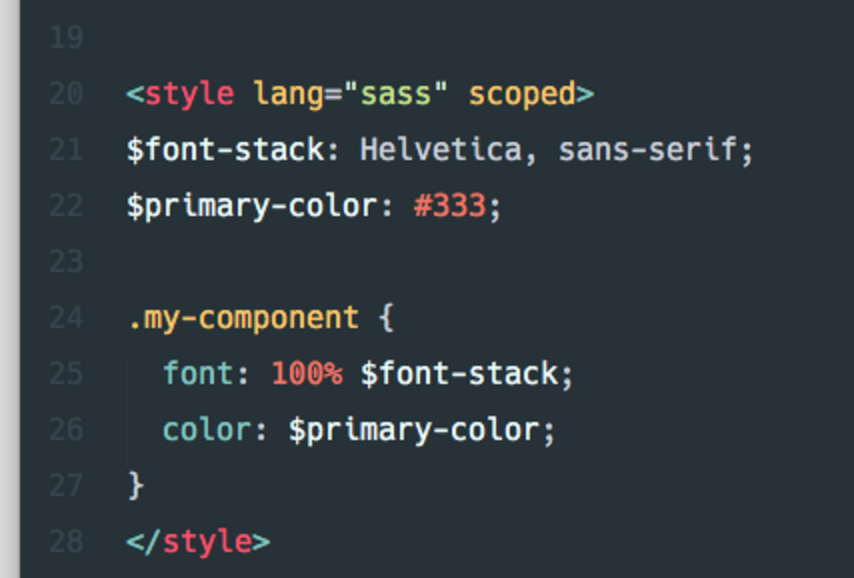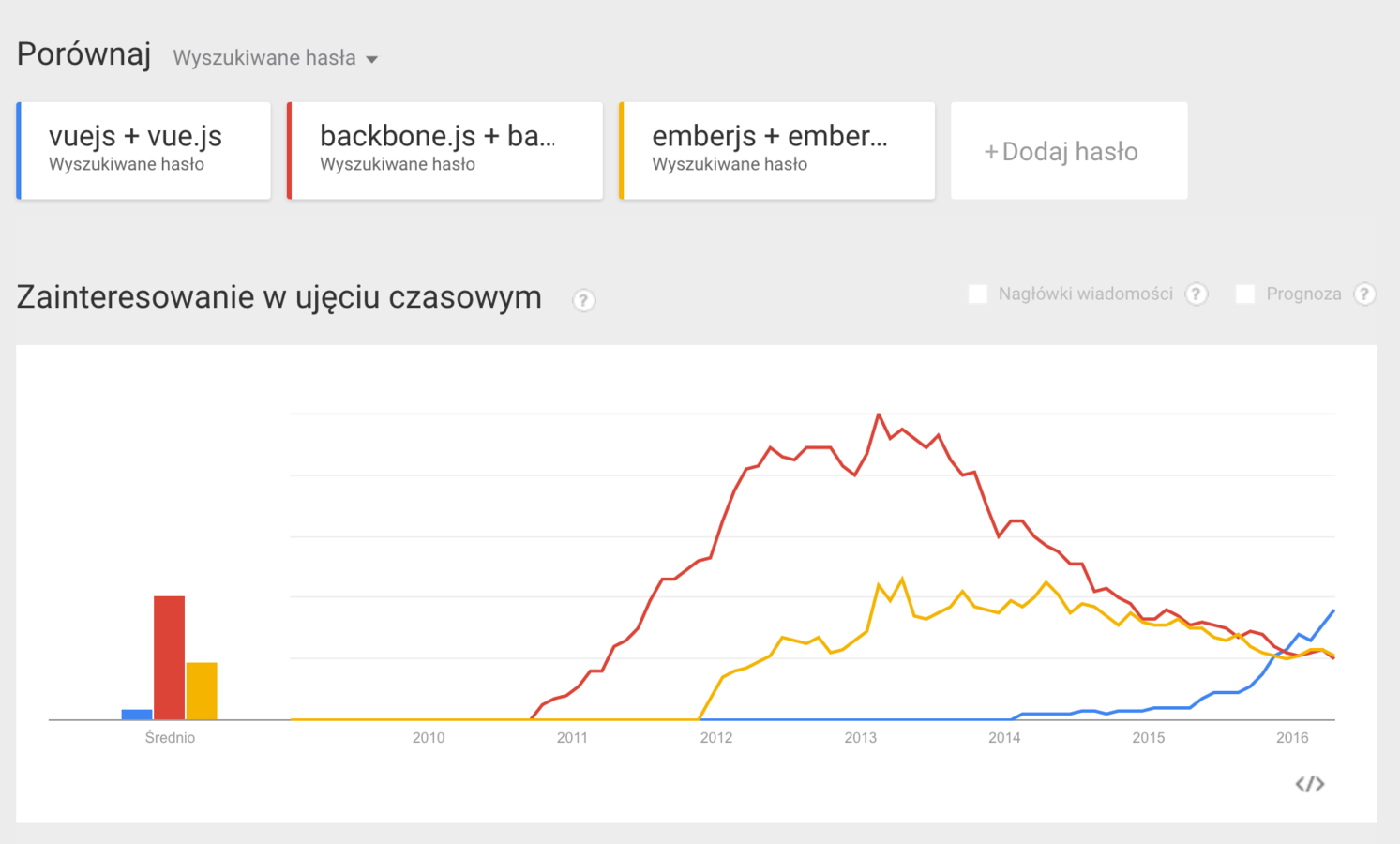Vue.js

Reactive Components for Modern Web Interfaces
Vue.js highlights

Vue.js – Intro
- View-layer library
- Simple & beautiful API
- Lightweight (~24kb min+gzip)
- Fast
- Reactive
- Component based
How to start?

Vue.js – Basics
var object = {
message: 'Hello world!'
}<div id="example">
{{ message }}
</div>new Vue({
el: '#example',
data: object
})This is now reactive!
Reactivity - how does it work?

Vue.js – Basics
When passing an object to the Vue instance as it’s data property, Vue.js walks through all it’s properties and converts them to getter/setters using Object.defineProperty.
For every directive / data binding in the template, there will be a corresponding watcher object. When a dependency’s setter is called, it triggers the watcher to re-evaluate, and in turn causes its associated directive to perform DOM updates.
Reactivity - how does it work

Vue.js – Basics


Vue.js – Basics
You can use it „jQuery style”. Just add the library from the CDN and you’re ready to go.
Simple to use
No need for JSX, Webpack / Browserify, TypeScript or silly React.createElement().
You can use it to enhance your old projects and keep using all your favorite tools: Slim, Sass, CoffeeScript or simply es5. Vue doesn’t care.

Vue.js – Basics
However if you decide to go for a full blown SPA, you get all the tools you need.
Going full SPA
Vue-cli
- Webpack / Browerify
- Hot reloading
- Linting
- Unit/e2e tests
- CSS extraction
Vue ecosystem
- Vue-router
- Vuex
- Vue-devtools
- Vue-touch
- Vue-validation
- and more...

Vue.js – Basics
Single
File
Component


Vue.js – Basics
Single
File
Component
(with preprocessors!)


Vue.js – Basics
What’s with the scoped attribute?

The one liner that prevents leaks of CSS outside of components.



Vue.js – Basics
Try it out!
Similarities with AngularJS

Vue.js – Similarities with AngularJS
Directives in template

Vue.js – Similarities with AngularJS
<!-- Vue syntax above
Angular 1.x syntax below -->
<h1 v-if="ok">{{ name }}</h1>
<h1 v-else>No</h1>
<h1 ng-if="ok">{{ name }}</h1>
<h1 ng-if="!ok">No</h1>
<input type="text" v-model="name">
<input type="text" ng-model="name">
<small v-show="!ok">{{ Not OK! | capitalize }}</small>
<small ng-show="!ok">{{ Not OK! | capitalize }}</small>
<a v-bind:href="url">Go back</a>
<a ng-href="{{ url }}">Go back</a>
<button v-on:click="doSomething">Do something</button>
<button ng-click="doSomething">Do something</button>Directives in template 2

Vue.js – Similarities with AngularJS
<!-- Vue syntax above
Angular 1.x syntax below -->
<div v-bind:class="{ 'class-a': isA, 'class-b': isB }"></div>
<div ng-class="{ 'class-a': isA, 'class-b': isB }"></div>
<ul id="example-1">
<li v-for="item in items">
{{ item.message }}
</li>
</ul>
<ul id="example-1">
<li ng-repeat="item in items">
{{ item.message }}
</li>
</ul>Shorthands in Vue

Vue.js – Similarities with AngularJS
<!-- full syntax -->
<button v-bind:disabled="someDynamicCondition">Button</button>
<!-- shorthand -->
<button :disabled="someDynamicCondition">Button</button>
or
<!-- full syntax -->
<a v-on:click="doSomething"></a>
<!-- shorthand -->
<a @click="doSomething"></a>Computed values

Vue.js – Features
<div id="example">
a={{ a }}, b={{ b }}
</div>var vm = new Vue({
el: '#example',
data: {
a: 1
},
computed: {
// a computed getter
b: function () {
// `this` points to the vm instance
return this.a + 1
}
}
})Computed setter

Vue.js – Features
// ...
computed: {
fullName: {
// getter
get: function () {
return this.firstName + ' ' + this.lastName
},
// setter
set: function (newValue) {
var names = newValue.split(' ')
this.firstName = names[0]
this.lastName = names[names.length - 1]
}
}
}
// ..
// When calling vm.fullName = 'John Doe', the setter will
// be invoked and vm.firstName and vm.lastName
// will be updated accordingly.Style bindings

Vue.js – Features
<div v-bind:style="{ color: activeColor, fontSize: fontSize + 'px' }"></div>
<!-- Works mostly the same as with classes -->Additionally
When you use a CSS property that requires vendor prefixes in v-bind:style, for example transform, Vue.js will automatically detect and add appropriate prefixes to the applied styles.
Transitions

Vue.js – Features
<div v-if="show" transition="expand"></div>/* always present */
.expand-transition {
transition: all .3s ease;
height: 30px;
padding: 10px;
background-color: #eee;
overflow: hidden;
}
/* .expand-enter defines the starting state for entering */
/* .expand-leave defines the ending state for leaving */
.expand-enter, .expand-leave {
height: 0;
padding: 0 10px;
opacity: 0;
}
Vue.js – Features
List rendering
var example1 = new Vue({
el: '#example-1',
data: {
items: [
{ message: 'Foo' },
{ message: 'Bar' }
],
object: {
FirstName: 'John',
LastName: 'Doe',
Age: 30
}
}
})<ul id="example-1">
<li v-for="item in items">
{{ $index }} – {{ item.message }}
</li>
</ul
or
<ul>
<template v-for="item in items">
<li>{{ item.msg }}</li>
<li class="divider"></li>
</template>
</ul>
<!-- Where the <template> element
won’t render -->
or
<div v-for="(key, val) in object">
{{ key }} {{ val }}
</div>Methods & Events handling

Vue.js – Features
var vm = new Vue({
el: '#example',
data: {
name: 'Vue.js'
},
// define methods under the `methods` object
methods: {
greet: function (user, event) {
// `this` inside methods point to the Vue instance
alert('Hello ' + user + ' this is ' + this.name + '!')
// `event` gives us access to original DOM event
}
}
})
// you can invoke methods in JavaScript too
vm.greet('Developers') // -> 'Hello Developers this is Vue.js!'<button @click="greet('Developers', $event)">Greet</button>Event modifiers

Vue.js – Features
<!-- the click event's propagation will be stopped -->
<a v-on:click.stop="doThis"></a>
<!-- the submit event will no longer reload the page -->
<form v-on:submit.prevent="onSubmit"></form>
<!-- modifiers can be chained -->
<a @click.stop.prevent="doThat">
<!-- just the modifier -->
<form v-on:submit.prevent></form>
<!-- only trigger handler if event.target is the element itself -->
<!-- i.e. not from a child element -->
<div @click.self="doThat">...</div>
<!-- Support for key aliases as modifiers -->
<input @keyup.enter="submit">
<!-- List of aliases: enter, tab, delete ,esc, space, up, down, left, right;
or create your own with Vue.directive('on').keyCodes.f1 = 112 -->Components

Vue.js – Components
<div id="example">
<my-component></my-component>
</div>// define
var MyComponent = Vue.extend({
template: '<div>A component!</div>'
})
// register globally
Vue.component('my-component', MyComponent)
// create a root instance
new Vue({
el: '#example'
})<!-- Which will render -->
<div id="example">
<div>A component!</div>
</div>Local registration

Vue.js – Components
var Child = Vue.extend({ /* ... */ })
var Parent = Vue.extend({
template: '...',
components: {
// <my-component> will only be available in Parent's template
'my-component': Child
}
})Props

Vue.js – Components
Vue.component('child', {
// declare the props
props: ['myProp'],
// the prop can be used inside templates, and will also
// be set as `this.msg`
template: '<span>{{ myProp }}</span>'
})<child my-prop="hello!"></child>
<!-- The prop will be passed as string -->Remember: When using camelCased prop names as attributes, you need to use their kebab-case equivalents.
Dynamic props

Vue.js – Components
<div>
<child :my-value="obj"></child>
</div>var Parent = Vue.extend({
template: '...',
components: {
Child
},
data: function () {
return {
obj: { name: 'Vue', ext: 'JS' }
}
}
})This will pass the whole object as prop.
Prop validation

Vue.js – Components
Vue.component('example', {
props: {
// basic type check (`null` means accept any type)
propA: Number,
// a required string
propB: {
type: String,
required: true
},
// a number with default value
propC: {
type: Number,
default: 100
},
// object/array defaults should be returned from a
// factory function
propD: {
type: Object,
default: function () {
return { msg: 'hello' }
}}}}Prop validation 2

Vue.js – Components
Vue.component('example', {
props: {
// indicate this prop expects a two-way binding. will
// raise a warning if binding type does not match.
propE: {
twoWay: true
},
// custom validator function
propF: {
validator: function (value) {
return value > 10
}
},
// coerce function (new in 1.0.12)
// cast the value before setting it on the component
propG: {
coerce: function (val) {
return val + '' // cast the value to string
}
}
}Slots

Vue.js – Components
<!-- Component template -->
<div>
<h1>This is my component!</h1>
<slot>
This will only be displayed if there is no content
to be distributed.
</slot>
</div>
<!-- Parent template -->
<my-component>
<p>This is some original content</p>
<p>This is some more original content</p>
</my-component>
<!-- Rendered result -->
<div>
<h1>This is my component!</h1>
<p>This is some original content</p>
<p>This is some more original content</p>
</div>(like transclusion in angularJS)
Named slots

Vue.js – Components
<!-- Component template -->
<div>
<slot name="one"></slot>
<slot></slot>
<slot name="two"></slot>
</div>
<!-- Parent template -->
<multi-insertion>
<p slot="one">One</p>
<p slot="two">Two</p>
<p>Default A</p>
</multi-insertion>
<!-- Rendered result -->
<div>
<p slot="one">One</p>
<p>Default A</p>
<p slot="two">Two</p>
</div>Dynamic components

Vue.js – Components
new Vue({
el: 'body',
data: {
currentView: 'home'
},
components: {
home: { /* ... */ },
posts: { /* ... */ },
archive: { /* ... */ }
}
})<component :is="currentView">
<!-- component changes when vm.currentview changes! -->
</component>Dynamic components 2

Vue.js – Components
<component :is="currentView" keep-alive>
<!-- inactive components will be cached! -->
</component>Vue.component('activate-example', {
activate: function (done) {
var self = this
loadDataAsync(function (data) {
self.someData = data
done()
})
}
})keep-alive
activate hook
Runs each time a component is dynamicaly swaped and at time of the inital render
transition-mode:
in-out
out-in
new in, then old out
old out, then new in
Compilation scope

Vue.js – Components
<!-- {{ msg }} will be compiled
using the parent’s scope -->
<child-component>
{{ msg }}
</child-component>Everything in the parent template is compiled in parent scope; everything in the child template is compiled in child scope.
Mixins

Vue.js – Mixins
// define a mixin object
var myMixin = {
created: function () {
this.hello()
},
methods: {
hello: function () {
console.log('hello from mixin!')
}
}
}
// define a component that uses this mixin
var Component = Vue.extend({
mixins: [myMixin]
})
var component = new Component() // -> "hello from mixin!"Mixing mixins

Vue.js – Mixins
var mixin = {
created: function () {
console.log('mixin hook called')
}
}
new Vue({
mixins: [mixin],
created: function () {
console.log('component hook called')
}
})
// -> "mixin hook called"
// -> "component hook called"Mixing mixins

Vue.js – Mixins
var mixin = {
methods: {
foo: function () {
console.log('foo')
},
conflicting: function () {
console.log('from mixin')
}
}
}var vm = new Vue({
mixins: [mixin],
methods: {
bar: function () {
console.log('bar')
},
conflicting: function () {
console.log('from self')
}
}
})
vm.foo() // -> "foo"
vm.bar() // -> "bar"
vm.conflicting() // -> "from self"Vue-Router

Vue.js – Plugins
import Vue from 'vue'
import Router from 'vue-router'
import App from './app.vue'
import ViewA from './view-a.vue'
import ViewB from './view-b.vue'
Vue.use(Router)
const router = new Router()
router.map({
'/a': { component: ViewA },
'/b': { component: ViewB }
})
router.start(App, '#app')<div>
<h1>This is the layout that won't change</h1>
<router-view><!-- matched component renders here --></router-view>
</div>Vuex

Vue.js – Plugins
import Vuex from 'vuex'
const state = {
counter: 0
}
const mutations = {
INCREMENT (state) {
state.counter++
}
}
export default new Vuex.Store({
state,
mutations
})store.dispatch('INCREMENT')
console.log(store.state.count) // -> 1
Vue.js – Plugins

Example flow

Vue.js – Plugins

Vue-devtools

Vue.js – Plugins

Vue.js vs Angular 1.x

Vue.js – Mixins
Simpler API and design.
Less opinionated, easier to combine with other libraries.
One-way data binding. Supports explicit two-way bindings.
Better performance and easier to optimize.
Complex API, hard to master.
Very opinionated, requires doing things angular-way.
Two-way bindings. Explicit one-way bindings (1.3+).
Dirty-checking. Nuff said.
Differences:
Vue.js vs Angular 1.x

Vue.js – Mixins
Components and directives
Template bindings (ng-if, ng-repeat vs v-if, v-for)
Concepts naming i.e. scope, watcher, directive, filters
Similarities:
Vue.js vs React

Vue.js – Mixins
DOM with references to real nodes.
Clean separation of HTML & JS. Easier to visually think about designs.
Prefers mutating state
Virtual DOM, rerender and patch DOM on every update.
Puts HTML inside JS. Easy to leak lots of logic inside render function.
Prefers immutable state
Differences:
Vue.js vs React

Vue.js – Mixins
Works on real DOM
Easy support for popular preprocessors for HTML, JS, CSS
Friendly for newcomers and easier to get productive fast
Actually more fun!
Tricky to perform DOM
manipulations
More Everything-in-JS approach
Due to functional nature, steeper learning curve
More platform-agnostic
Differences:
Vue.js vs React

Vue.js – Mixins
Reactive and based on components
Just the View layer. Support for different state management solutions e.g. Flux/Redux. Vue also introduces Vuex and bindings for Redux (like revue)
Performant!
Similarities:
Growing popularity

Vue.js

Some stats (2015)

Vue.js
General
- NPM downloads: 382,184 ytd, ~52k/month current
-
GitHub Stars: 11,357 current
Repo Activity
-
Releases: 54 ytd (from 0.11.5 to 1.0.12, including alpha/beta/rc releases)
-
Commits: 1,023 ytd
-
Issues Closed: 1,014 ytd
-
Pull Requests Merged: 69 ytd from 43 contributors
Vuejs.org
-
Page views: 3,761,728 ytd
-
Unique visitors: 363,365 ytd
-
30 Day Active Users: 76,090 current

Vue.js
Yes, this is a personal project. So if you are looking for an enterprise backed dev team, Vue is probably not the one. But I’d rather look at the numbers. Vue has maintained 100% test coverage on every single commit since the 0.11 rewrite, and that will continue. GitHub issues are closed within an average of 13 hours, and there has been 1400+ of them. As of this writing, there are literally zero open and reproducible bugs.
— Evan You, Vue.js author
http://blog.evanyou.me/2015/12/20/vuejs-2015-in-review/
Enjoy The Vue
By Damian Dulisz
Enjoy The Vue
Quick Tour on Vue.js
- 2,805



